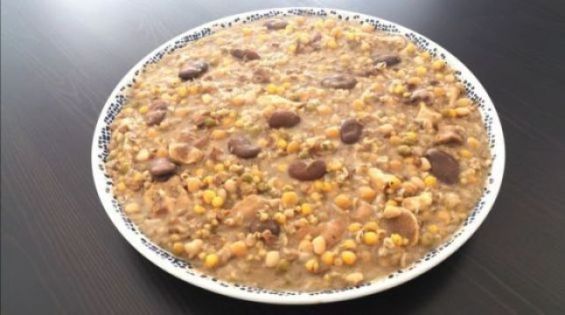From thick porridges and vegetable preparations to semolina made from ancient seeds, Yennayer is undoubtedly a celebration of the earth's abundance, a sign of gratitude for the annual harvest it yields. In this sense, the Amazigh New Year is distinguished by the preparation of a number of dishes featuring local produce. These are mainly seeds and foodstuffs grown over the centuries, carefully preserved in collective granaries such as igoudar.
Still the subject of debate among historians, the Amazigh calendar's reference date is almost unanimously attributed to the enthronement of Pharaoh Sheshonq I, in 950 BC. An occasion made official in Morocco, which celebrates Yennayer on January 14th of each year in the Gregorian calendar, this New Year's Day is an opportunity to widely share the ancestral foods from the harvests that this date has symbolized down the centuries.
.jpg)
While some communities opt for tagoula as the main course of their festive dinner, others prefer a barley- or corn-based couscous, often accompanied by seasonal vegetables and very rarely meat. But there's still plenty to choose from, especially for lovers of ourkimen, a specialty of Anti-Atlas feasts.
In Tafraout in particular, ourkimen is a family dish based on handfuls of various legumes, soaked in water before cooking: lentils, broad beans, chickpeas, split peas, white beans... It's even from this principle that the name of the dish is inspired, derived from the Amazigh term «irkm», which refers to the traditional soaking method. It's accompanied by onions, barley seeds, turnip greens, cumin, and cinnamon (depending on availability), not forgetting the inevitable olive oil.
Depending on local usage, some variations may also include tomatoes, ginger, and turmeric, or other dried vegetables, food stocks permitting. The principle remains the same, as with many Amazigh preparations, which retain common bases but can be elaborated or adapted to suit the agricultural season, whether lean or abundant.
A common basis for preparation around the Mediterranean
The secret of ourkimen's success is the same as that of many traditional dishes: slow cooking over a low heat, ideally over a wood fire, produces a thick, hearty soup. For a creamier preparation, add a handful of corn or barley semolina.
If the annual harvest is abundant enough to stock dried meats, ourkimen can also be accompanied by goat's feet, giving the dish flavors close to the more commonly accepted «kouraïne». Beyond Morocco, the tradition of dishes based on goat's feet, veal, or beef is widely shared in North Africa and the Mediterranean.
In the southeast of France, Auvergne-Rhône-Alpes is one of the main centers of this tradition. In Saint-Étienne, the tradition dates back to the 19th century. In this region, long known for its textile and metal industries, calf's trotters are served especially in celebration of Saint Barbara's Day, which marks the start of the Christmas festivities. A local specialty, this dish is simmered with vegetables, spices, and a vinegar sauce.
.jpg)
In France, the best-known version is pig's trotter, one of the culinary emblems of Sainte-Menehould in the Grand-Est region. Depending on the region and country, several other variations exist. Some accounts link them to Yiddish culinary practices in Europe, or Sephardic in North Africa, which have their origins in preparations dating back centuries, if not millennia.





 chargement...
chargement...













